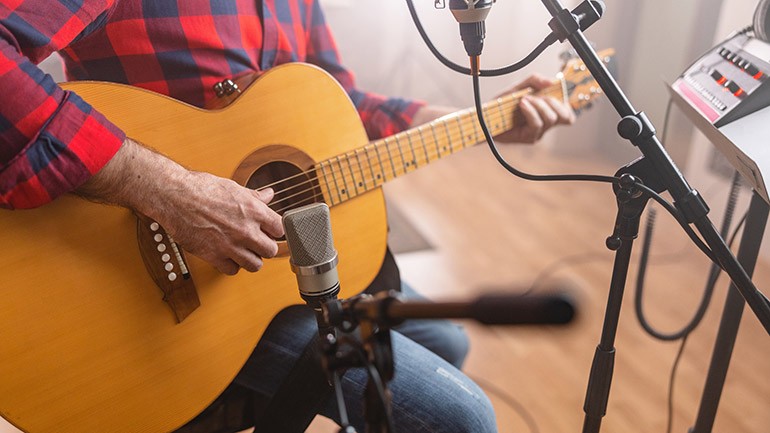Five Microphone Maneuvers That Matter
Tried-and-true miking strategies to help you get the best-sounding signal possible

When you’re first getting started with home recording, you’re probably not paying that much attention to the intricacies of the microphone—you may be lucky to own just one and putting it somewhere in the vicinity of the sound source is often good enough. But particularly as you learn about the different types of mics and their various uses, you’ll find that developing your placement skills is a big part of improving your overall craft as a recording artist. To wit, here are some common situations you’re likely to encounter on any given track, and some of the tried-and-true maneuvers that will help you get the best-sounding signal possible.
Go off-axis. Unlike vocals which generally call for a front-and-center approach, certain amplified instruments such as electric guitar, bass or keyboard may sound shrill or trebly if a dynamic mic is pointed straight at the speaker cone. In reality, the so-called “sweet spot” is likely somewhere between the speaker’s center and its outer edge—to find it, put on a set of headphones and slowly move the mic towards the lower side of the speaker until the sound becomes rounder and less edgy. This “off-axis” positioning is especially helpful for ensuring lead-guitar tones are sufficiently warm and full-bodied.
Pad it down. Because they are considerably “hotter” than dynamics or other non-powered models, condenser microphones are capable of picking up a much wider range of sound. But that sensitivity can also work against you when recording anything that’s naturally louder, including drums, electric instruments, piano and even some acoustic guitars. This is why most condensers include a “pad” switch, which reduces the microphone’s gain level (usually in 5-10 decibel increments), thereby keeping the signal from distorting on the way to the recorder. When used as a drum overhead or in front of a guitar amp, for instance, you’ll want to select the lowest volume threshold available, or at least to the point where the level isn’t immediately going into the red.
More bass, please. Another benefit of a condenser mic is its ability to provide a wider frequency response, which is particularly helpful when seeking a richer lead-vocal sound. When condensers were first brought to this country from Germany at the end of World War II, it was old crooner Bing Crosby who discovered that the closer you got to the mic, the bassier the tone became. This “proximity effect” allowed artists to sing in a more intimate manner and has been a mainstay technique ever since. When doing this at home, keep at least a few inches between yourself and the center of the mic so that the vocal is rounded but not overly muddy.
Bottom out. On the other hand, it’s helpful to be able to adjust the amount of high or low end at the source, rather than trying to correct with equalization after the fact. In addition to its level function, a condenser mic also offers a high-pass filter switch for reducing bass overmodulation, which can be particularly handy on vocals as it allows you to achieve some of the proximity effect mentioned above, while also keeping the sound properly focused.
Record the room. While there’s no denying the convenience of increasingly sophisticated plugins and other emulators, recording everything directly (or “in the box”) puts your work at risk of sounding a bit too sterile. To restore some sense of space, consider running any direct-patched track through a vocal monitor or standalone speaker and placing a condenser mic on a boom stand nearby to capture the indirect signal. When mixing, blend some of the “ambient” track with the original until you achieve a wider, roomier sound.






Community
Connect with BMI & Professional Songwriters